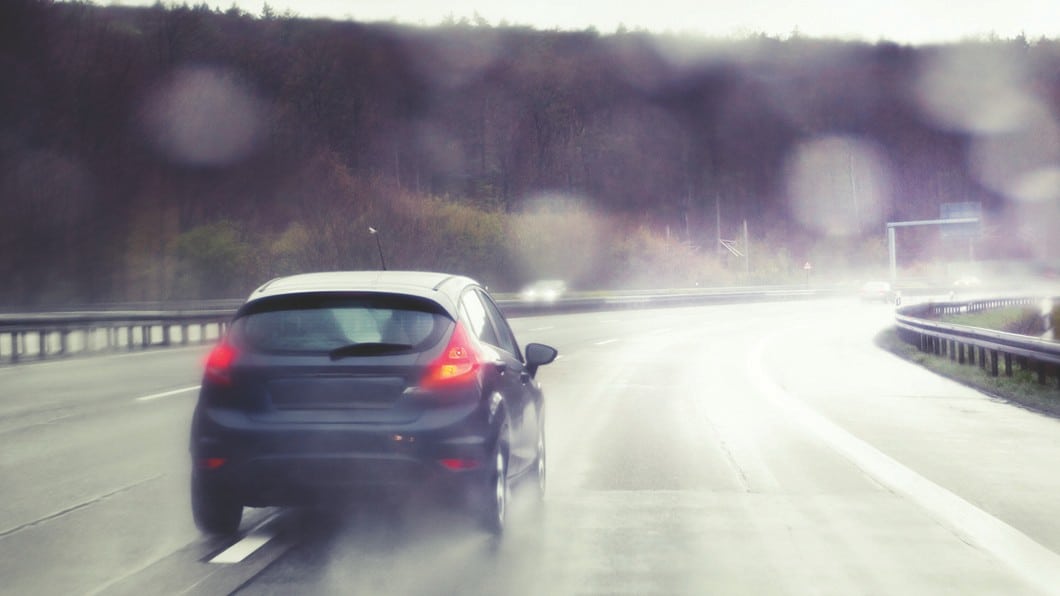In the UK we are so used to driving in wet weather that we often become complacent about safety. This is one of the reasons that such a high percentage of accidents take place on our roads because we simply don’t adjust our driving habits and take any changes in weather conditions into consideration.
After a long dry spell the first few days of rain are the most hazardous because a roads surface may become extremely slippery. With a steady flow of traffic the roads surfaces will have build up a grimy layer comprising of oil, dust, leaves and tyre debris etc as well as passengers themselves throwing things out of their window. It can take a few days to wash all this muck away and until it does the combination of water and greasy surface can have a big impact on the way a vehicles tires react to a roads surface.
When it does rain the safest thing to do is reduce your speed and leave more room between yourself and the vehicle in front of you. A wet road will require a breaking distance of at least twice that of a dry road and if your tire tread is low then the distance required to stop can be a lot more.
Test research undertaken at MIRA (The Motor Industry Research Association) has shown that increasing a tires tread from the current UK minimum of 1.6mm to 3mm will increase a vehicles performance in wet weather by up to 25%. This can mean an extra reduction of 25m in stopping distance which is a substantial amount when you need to stop in a hurry.
To account for the extra time it may take to stop your vehicle in wet weather you should leave a safe distance between yourself and the vehicle in front of you. The other things you can do to make driving in poor conditions safer are:
- Keep your lights clean and free from dirt and use them when it’s raining or visibility is poor not only so that you can see what’s ahead of you, but so that other vehicles are more aware of you.
- Replace worn wipers so that when ever you use them your windscreen is kept as clean as possible.
- Demist your vehicle’s windows so that you have a good visibility of what’s around and try to keep the inside of your windows clean as they will then be less susceptible to misting up.
- Remember that other vehicles are also suffering from poor visibility and as such even though you can see them it doesn’t mean that they have noticed you.
- As already stated keep a safe distance from the vehicle in front of you a gap of at least three cars lengths is the recommended distance for travelling behind a vehicle to allow for extra reaction and stopping time. It also helps to keep any spray from the vehicle in front of you to a minimum and improve your visibility.
- The most obvious advise is to ‘Slow down’ which in turn will reduce the chances of your vehicle aquaplaning, which is caused by a layer of water creating a barrier between your tires and the roads surface and is extremely dangerous as you can imagine. (To help prevent aquaplaning aside from keeping your speed down you should keep your tires inflated to the correct pressure and make sure your vehicle tires have adequate tread. If your vehicle does start to lose traction and glide on the waters surface you should avoid accelerating or breaking and instead press down the clutch (on an automatic you should put the car into neutral) to let the vehicle slow down on its own. With a firm grip on the steering wheel try and steer as safely as you can until you are out of the water.
- Never drive if you are tired of feeling sleepy.
Many of the UK’s roads also suffer from getting water logged when there are heavy downpours because they simply don’t have adequate drainage systems in place to keep the road water free. If you do come across a road that’s covered with water be sure that it’s not too deep or fierce before entering it and remember 2 feet of rapidly flowing water can wash a car away. When in doubt turn your vehicle around and find an alternative route.
If you do decide to drive through the water:
- Don’t drive through any water that’s moving fast
- First let any oncoming traffic pass bye
- Reduce your speed and put the vehicle into first gear and keep the engines revs high to help keep any water out of the exhaust.
- Drive slowly and steadily to avoid causing waves, soaking pedestrians and avoiding damage to your vehicle. It will only take a small amount of water to enter the air intake to damage the vehicles engine and land you with a nice repair bill.
- Always test your breaks after exiting water to make sure they are still functioning correctly.
If your vehicle does break down while you are travelling through water and it starts to rise or become fierce, make sure you exit the vehicle and head to safety as quickly as you can. It may only take a few feet of rapidly flowing water for the vehicle to get swept away.
Should your vehicle break down in wet weather, never open the bonnet and leave it exposed to the rain while you are waiting for the emergency services to arrive. Soaking the vehicles electronics will only make the job of re starting the vehicle a lot more difficult.


